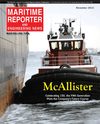
Page 57: of Maritime Reporter Magazine (November 2014)
Workboat Edition
Read this page in Pdf, Flash or Html5 edition of November 2014 Maritime Reporter Magazine
www.marinelink.com 57 most companies today realize that it’s not only engines. You have to look at all of the systems, including the transmis- sions, to keep your boat running and to keep it operational.”
According to Körner the change in attitudes on maintenance is palpable, and the days of running until failure is becoming the exception rather than the rule. Managed maintenance is the trend, particularly with the big operators, as they seek the path of regular investment in the name of operational continuity. “So today they are really looking and saying, ‘Okay, the recommendation of the manufacturer is to change the bear- ing after 40,000 hours; so they change the bearing, even if it still looks OK, be- cause they want to be sure that they have the next 40,000 hours operation without problems.”
Meissner contends that preventative maintenance versus ‘run until fail’ is an effective means to positively impact the bottom line. “When you have a fail- ure, that boat could be 700 miles from your facility; Now it’s broken 700 miles away,” Meissner said. “But if you schedule your preventative maintenance overhaul, you can bring the boat in during a down time in your busi- ness, do the maintenance at your facility where all of the parts, or maybe a swing gear is on-hand, and this helps to make it a more manageable and cost ef? cient operation” rather than waiting for an emergency repair.
Government Markets
In addition to the yacht, pleasure boat and workboat business, ZF has a large and vibrant government and navy busi- ness, with several cornerstone contracts including the U.S. Coast Guard’s FRC project, and the U.S. Navy’s JHSV project. Government and Navy work require a different level of solution, as
Körner explains. “(On the government of the business) you have to of course meet the requirements from the navies and from the boat builders, speci? cally the military speci? cations in regards to shock and vibration, for example. But besides the product itself, you provide services such as manuals, spare parts list in a special forms, electronic repair in- structions, and these kind of things. The service around the transmission itself is more demanding than you have today in a commercial business. So this is an ongoing investment, and one that we are happy to make.”
And today coast guard and navy busi- ness is booming, and not just in the U.S.
In the Far East it is booming as tensions in the China Sea area have resulted in a huge number of boats being built for and in the region. Asia Paci? c, India and the Middle East markets are all running strong. Demands to this market niche are similar to the yacht business in the demand for light, strong, quiet and reli- able transmissions. Demand for service, training and spares has never been high- er. The U.S. Coast Guard FRC boats are a great example, as the Coast Guard said “We don’t just want supply of a product, we want support from ZF with our crews that are being brought on each boat as part of the commissioning process,” said
Körner. “So the crews come to the ZF facility in Miramar, FL for a weeklong training course on basics of transmission technology, theory and ? rst level diag- nostics.” (Continued from page 55)
MR #11 (50-57).indd 57 10/30/2014 9:45:30 AM

 56
56

 58
58
